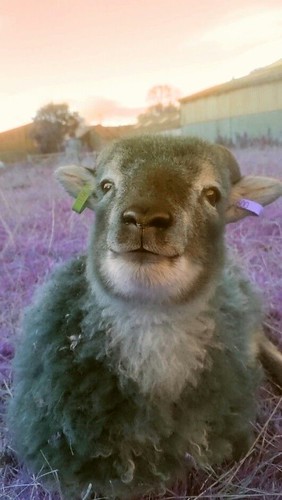 a smiling soay lamb to make everybody feel happy
a smiling soay lamb to make everybody feel happy
A new month has started together with what feels like a new bionic bunny “me”. No kidding: it has been a total “seeing the light” moment in the last few weeks and it “hit me” how absolutely crap I was doing when I was looking something up on my blog for someone and the date was 2013, and the blog started by saying I had fainted and fallen down… that was SIX years ago ! Who knows how long I have been putting up with feeling abysmal and a dodgy heart !
A good friend of mine popped in a few days ago and she hadn’t seen me since Bendigo…she said it was day and night difference in a good way. LOL And it’s true, it’s amazing.
I am still not doing ALL the things I want to do, but the energy is back and also the excitement to tackle new things, come up with new ideas, paint !, draw !, design! All the things that I have not felt I had the energy for and was frustrating me to no end. Well, no more ! 😊
It’s totally liberating and just goes to show that there is a need to get yourself checked out on a regular basis and not take “feeling bad” for granted, because it never is! No matter how much we keep telling ourselves it’s because we work too hard or are getting older.
Anyway, there are some really exciting things planned in the next couple of months, so keep checking this space ! I also have been having fun drawing and inking again, participating in the #Inktober challenge. Check it out on Instagram! It’s a lot of fun and gets the creative juices flowing for sure ! I have been doing this challenge now for three years and I love it. Check what I have been doing on my Instagram and facebook pages. Prints will be for sale soon after Inktober has finished and originals as well, so again, keep an eye on this space 😊
Now that I am in this phase of “never leave anything too long and go to the doctor” I also had certain things checked I was worried about and I have to go back to the doctors in the course of next week to get a melanoma removed from my face..ouch! but it is looking pretty early stages and tiny-ish so my chance of becoming “Scar Face” is not happening thankfully and all the other “spots” I was much more worried about were absolutely nothing to worry about at all ! So it’s all full steam ahead and having fun ! Again, for all of you out there , especially my friends in Australia, get your skin checked out regularly !
This week there are some super special Outlander tops with its’ magnificently soft Soay sheep , this time with more silk and extra lush to spin!
Here is some information about these amazing tiny super soft Saoy sheep for you:
The rare sheep breed in the spot light is the very special soay sheep of the Scottish Islands of St Kilda and Hirta ! It is a very, very rare ancient breed, with roots going back all the way to the bronze age !
The Isle of Soay, a name derived from the Norse word for Sheep Island, is near the North West corner of Hirta. A very dangerous, narrow channel and sea stacks separate the two. Soay is extremely difficult to access due to its steep rocky cliffs, boulder fields and lack of anchorage.
It can only be approached when seas are very calm and quickly changing weather can make getting off the island nearly impossible, it is the least accessible of all the islands in the archipelago. It is believed that sheep have probably inhabited Soay since the Bronze Age and are the descendants of the very first domesticated sheep which populated northern Europe. They are the most primitive surviving livestock breed in the UK.
The sheep on Soay Island were not owned by the St. Kildans of Hirta, but instead by the islands various lairds (landlords). Their feudal tenants were allowed to annually collect fleece from these sheep and were occasionally permitted to take an animal, for a fee, to kill for special occasions. While Soay is somewhat larger (244 acres) than its neighbour Boreray (189 acres) Soay supports fewer animals per acre because its high central plateau is a marshy bog with little vegetation suitable to grazing sheep.
A good friend of mine popped in a few days ago and she hadn’t seen me since Bendigo…she said it was day and night difference in a good way. LOL And it’s true, it’s amazing.
I am still not doing ALL the things I want to do, but the energy is back and also the excitement to tackle new things, come up with new ideas, paint !, draw !, design! All the things that I have not felt I had the energy for and was frustrating me to no end. Well, no more ! 😊
It’s totally liberating and just goes to show that there is a need to get yourself checked out on a regular basis and not take “feeling bad” for granted, because it never is! No matter how much we keep telling ourselves it’s because we work too hard or are getting older.
Anyway, there are some really exciting things planned in the next couple of months, so keep checking this space ! I also have been having fun drawing and inking again, participating in the #Inktober challenge. Check it out on Instagram! It’s a lot of fun and gets the creative juices flowing for sure ! I have been doing this challenge now for three years and I love it. Check what I have been doing on my Instagram and facebook pages. Prints will be for sale soon after Inktober has finished and originals as well, so again, keep an eye on this space 😊
Now that I am in this phase of “never leave anything too long and go to the doctor” I also had certain things checked I was worried about and I have to go back to the doctors in the course of next week to get a melanoma removed from my face..ouch! but it is looking pretty early stages and tiny-ish so my chance of becoming “Scar Face” is not happening thankfully and all the other “spots” I was much more worried about were absolutely nothing to worry about at all ! So it’s all full steam ahead and having fun ! Again, for all of you out there , especially my friends in Australia, get your skin checked out regularly !
This week there are some super special Outlander tops with its’ magnificently soft Soay sheep , this time with more silk and extra lush to spin!
Here is some information about these amazing tiny super soft Saoy sheep for you:
The rare sheep breed in the spot light is the very special soay sheep of the Scottish Islands of St Kilda and Hirta ! It is a very, very rare ancient breed, with roots going back all the way to the bronze age !
The Isle of Soay, a name derived from the Norse word for Sheep Island, is near the North West corner of Hirta. A very dangerous, narrow channel and sea stacks separate the two. Soay is extremely difficult to access due to its steep rocky cliffs, boulder fields and lack of anchorage.
It can only be approached when seas are very calm and quickly changing weather can make getting off the island nearly impossible, it is the least accessible of all the islands in the archipelago. It is believed that sheep have probably inhabited Soay since the Bronze Age and are the descendants of the very first domesticated sheep which populated northern Europe. They are the most primitive surviving livestock breed in the UK.
The sheep on Soay Island were not owned by the St. Kildans of Hirta, but instead by the islands various lairds (landlords). Their feudal tenants were allowed to annually collect fleece from these sheep and were occasionally permitted to take an animal, for a fee, to kill for special occasions. While Soay is somewhat larger (244 acres) than its neighbour Boreray (189 acres) Soay supports fewer animals per acre because its high central plateau is a marshy bog with little vegetation suitable to grazing sheep.
.jpg) |
| the Island of sheep |
St. Kilda is a group of islands which are the most westerly part of Scotland; they are 41 miles from Benbecula in the Outer Hebrides and 110 miles from the Scottish mainland.
This archipelago consists of four small islands and some large rocky outcrops which are all that remains of a long extinct volcano. The islands are remote and spectacular with the highest cliffs in the UK and are the home to large colonies of seabirds.
There is evidence that the main island Hirta has been inhabited for thousands of years but the habitation might not have been continuous. There is also evidence of human activity on the other three islands of Dun, Soay and the more remote Boreray.
The island of Soay has been the home of the most primitive form of domestic sheep in the UK for thousands of years which have remained as a relic of early domestication due to isolation and inaccessibility. The islanders, known as the St. Kildans were the tenants of various owners of St. Kilda, they had limited resources other than the vast seabird colonies. They caught thousands of these birds and used their feathers and extracted their oil as a currency to pay their rent and to buy meagre provisions.
The most remote island of the archipelago is Boreray which was used by the St. Kildans to harvest sea birds and their eggs and also keep a reserve flock of their unique domestic sheep, now known as Boreray Sheep.
As more communications with the mainland improved the life of the islanders changed, they were subject to diseases brought by contact with outsiders which caused heavy mortality. There was movement to the mainland and immigration to other parts of the world until in 1930 the population became so low with so few able bodied men they could no longer sustain themselves and they chose to leave. In 1957, the entire archipelago was bequeathed to the National Trust for Scotland and has been in their ownership and protection ever since.
Here is some amazing footage of St Kilda Island and its Soay sheep (the sheep story arrives at around 5mins30secs in)
The animals on Soay have never been managed and lived feral on the island for thousands of years, no one is certain how long or how they got there.
There are dark and blond sheep with some ewes being horned and many others polled (no horns) or scurred (small or misshaped horns). Over recent centuries some animals have been taken from Soay to estates on the mainland of the UK. Over a period of time starting in 1932, after St. Kilda had been evacuated and sold, 107 animals were captured and transferred to the vacant pastures of Hirta.
This was a significant number taken from the small population on Soay Island. Today flocks survive in both locations.
Visitors to St Kilda will immediately notice three striking features of the sheep.
First, Soay sheep are tiny. In August, mature females average around 24kg in weight while mature males are around 38kg, making them about one third the size of most modern domestic sheep and shrinking !
This archipelago consists of four small islands and some large rocky outcrops which are all that remains of a long extinct volcano. The islands are remote and spectacular with the highest cliffs in the UK and are the home to large colonies of seabirds.
There is evidence that the main island Hirta has been inhabited for thousands of years but the habitation might not have been continuous. There is also evidence of human activity on the other three islands of Dun, Soay and the more remote Boreray.
The island of Soay has been the home of the most primitive form of domestic sheep in the UK for thousands of years which have remained as a relic of early domestication due to isolation and inaccessibility. The islanders, known as the St. Kildans were the tenants of various owners of St. Kilda, they had limited resources other than the vast seabird colonies. They caught thousands of these birds and used their feathers and extracted their oil as a currency to pay their rent and to buy meagre provisions.
The most remote island of the archipelago is Boreray which was used by the St. Kildans to harvest sea birds and their eggs and also keep a reserve flock of their unique domestic sheep, now known as Boreray Sheep.
As more communications with the mainland improved the life of the islanders changed, they were subject to diseases brought by contact with outsiders which caused heavy mortality. There was movement to the mainland and immigration to other parts of the world until in 1930 the population became so low with so few able bodied men they could no longer sustain themselves and they chose to leave. In 1957, the entire archipelago was bequeathed to the National Trust for Scotland and has been in their ownership and protection ever since.
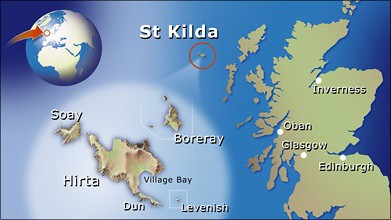 |
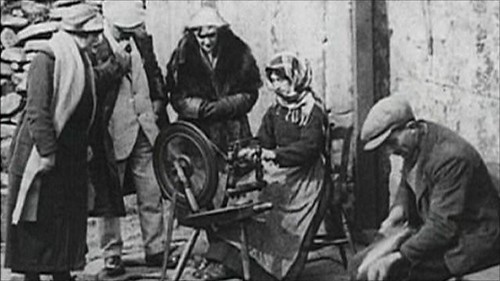 |
| Tourists flocking around a spinner showing them spinning soay (1900s) |
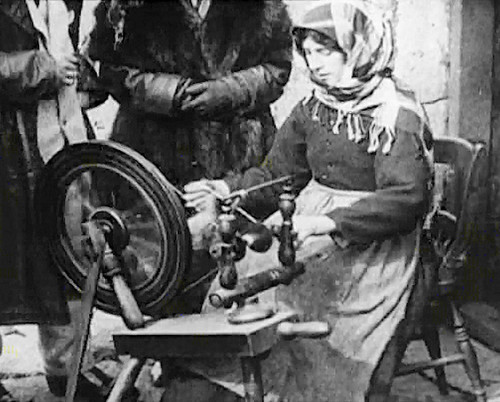 |
| close up |
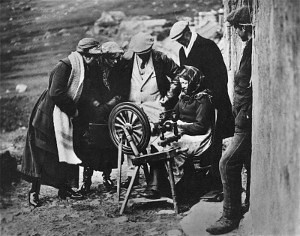 |
| spinning magic |
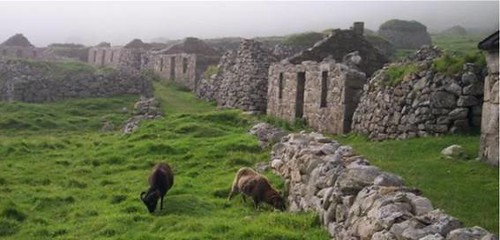 |
| now the same street is deserted... except for the grazing soay sheep that have been there for centuries |
Here is some amazing footage of St Kilda Island and its Soay sheep (the sheep story arrives at around 5mins30secs in)
There are dark and blond sheep with some ewes being horned and many others polled (no horns) or scurred (small or misshaped horns). Over recent centuries some animals have been taken from Soay to estates on the mainland of the UK. Over a period of time starting in 1932, after St. Kilda had been evacuated and sold, 107 animals were captured and transferred to the vacant pastures of Hirta.
This was a significant number taken from the small population on Soay Island. Today flocks survive in both locations.
Visitors to St Kilda will immediately notice three striking features of the sheep.
First, Soay sheep are tiny. In August, mature females average around 24kg in weight while mature males are around 38kg, making them about one third the size of most modern domestic sheep and shrinking !
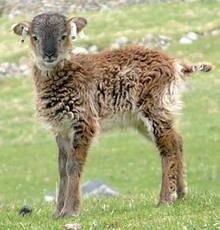 |
Second, they are highly variable in appearance. While many Soays have the ‘classic’ Soay coat colour, which we call ‘dark wild’ (with ‘wild’ being short for ‘wildtype’ the coat pattern that features a light belly and rump patch), we recognise three other varieties (‘dark self’, ‘light wild(type)’ and ‘light self’ (where ‘self’ refers to ‘self-coloured’ – a coat pattern with the same colour all over including belly and rump patch).
Studies have shown that the dark/light colouration is due to a gene called tyrosinase-related protein 1, or TYRP1 which is on sheep chromosome 2 and genetically dark is dominant to light, while the wild/self colouration is due to the locus Agouti on sheep chromosome 13 and wild is dominant to self.
There are however, very cute Soay sheep with white patches as well. (note: in angora rabbits for example there is the agouti on chromosome 13 as well, making the off spring able to have all different colours. Agouti is a gorgeous thing to have in the gene pool !).

Studies have shown that the dark/light colouration is due to a gene called tyrosinase-related protein 1, or TYRP1 which is on sheep chromosome 2 and genetically dark is dominant to light, while the wild/self colouration is due to the locus Agouti on sheep chromosome 13 and wild is dominant to self.
There are however, very cute Soay sheep with white patches as well. (note: in angora rabbits for example there is the agouti on chromosome 13 as well, making the off spring able to have all different colours. Agouti is a gorgeous thing to have in the gene pool !).
 |
The University of Edinburg is doing a lot of research on these soay sheep because it offers them a very good insight in the ecology and the evolution of the species. A count of the whole of Hirta’s Soay sheep population has been conducted most years since 1952 by the same method.
It was these counts that revealed that Soay sheep on St Kilda have rather unusual population dynamics. The Soay population rises to maxima and then crashes, at irregular intervals. It is this population dynamic behaviour that makes Soay sheep so interesting for ecologists. The sheep exhibit a phenomenon known as overcompensatory density dependence, in which their population never reaches equilibrium.
The population growth is so great as to exceed the carrying capacity of the island, which eventually causes a dramatic population crash, and then the cycle repeats. For example, in 1989, the population fell by two thirds within 12 weeks !!
In brief, it became clear that the population dynamics of Soay sheep happen because virtually all mature females conceive each year, regardless of density, and as a result, the population can increase in one breeding season to a size which greatly exceeds the winter carrying capacity, when it may crash. Crashes are more likely to occur when there is bad winter weather, and when the population contains a large proportion of vulnerable sheep such as lambs and males. The population then increases again, over several years, before another crash.
As ecological research proceeded, it became clear that the Soay sheep population also offers remarkable opportunities for understanding the progress of natural selection and evolution in real time. Population crashes are a period of intense selection, could they have anything to do with the maintenance of genetic variation, for example in coat colour and horn type? Does the low life expectancy of most individuals select for early reproductive effort? Likewise, the population dynamics research inspires numerous questions about the relationship between the sheep and their biotic environment, including the plants on which they feed and the parasites.
The Soay sheep have short tails and naturally shed their wool, which can be hand plucked (called rooing) in the spring and early summer. About one kilogram of wool can be obtained from each animal per year.
It was these counts that revealed that Soay sheep on St Kilda have rather unusual population dynamics. The Soay population rises to maxima and then crashes, at irregular intervals. It is this population dynamic behaviour that makes Soay sheep so interesting for ecologists. The sheep exhibit a phenomenon known as overcompensatory density dependence, in which their population never reaches equilibrium.
The population growth is so great as to exceed the carrying capacity of the island, which eventually causes a dramatic population crash, and then the cycle repeats. For example, in 1989, the population fell by two thirds within 12 weeks !!
In brief, it became clear that the population dynamics of Soay sheep happen because virtually all mature females conceive each year, regardless of density, and as a result, the population can increase in one breeding season to a size which greatly exceeds the winter carrying capacity, when it may crash. Crashes are more likely to occur when there is bad winter weather, and when the population contains a large proportion of vulnerable sheep such as lambs and males. The population then increases again, over several years, before another crash.
As ecological research proceeded, it became clear that the Soay sheep population also offers remarkable opportunities for understanding the progress of natural selection and evolution in real time. Population crashes are a period of intense selection, could they have anything to do with the maintenance of genetic variation, for example in coat colour and horn type? Does the low life expectancy of most individuals select for early reproductive effort? Likewise, the population dynamics research inspires numerous questions about the relationship between the sheep and their biotic environment, including the plants on which they feed and the parasites.
The Soay sheep have short tails and naturally shed their wool, which can be hand plucked (called rooing) in the spring and early summer. About one kilogram of wool can be obtained from each animal per year.
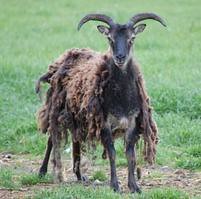 |
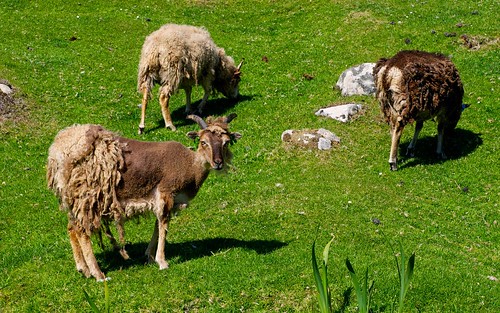 Soay sheep shed their fleece leaving them to look a bit bedraggled |
This breed has extremely fine fleece and it is difficult to distinguish an outer coat. This is a clear indication that the Soay are indeed the product of a domesticated breed in prehistoric times.
The breed also lacks the flocking instinct of many breeds. Attempts to work them using sheep dogs result in a scattering of the group: no use entering them at the Bendigo sheep and wool show dog trials: it would be extremely frustrating for the sheep and dogs. They obviously are the rebels among sheep !
The breed also lacks the flocking instinct of many breeds. Attempts to work them using sheep dogs result in a scattering of the group: no use entering them at the Bendigo sheep and wool show dog trials: it would be extremely frustrating for the sheep and dogs. They obviously are the rebels among sheep !
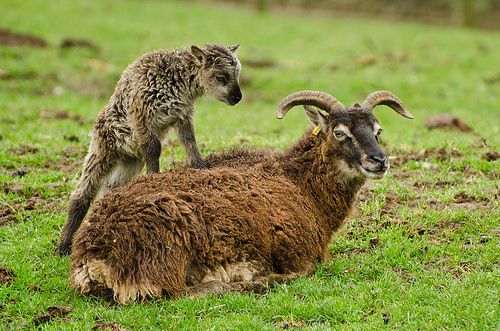 |
| A Soay lamb and his mum |
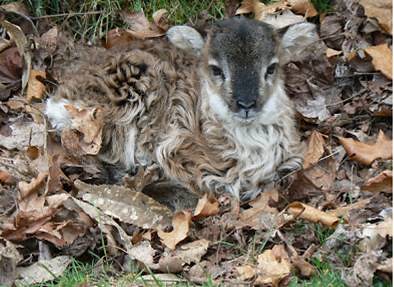 |
| a one day old Soay sheep lamb blending in with some autumn leaves |
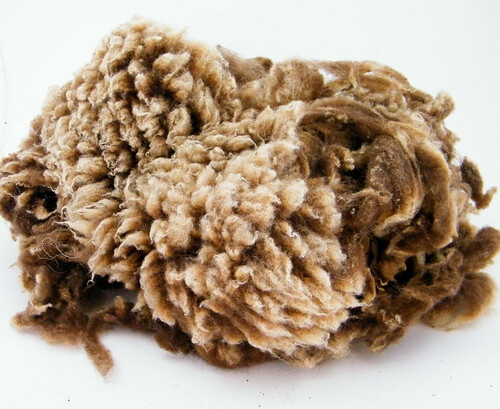 |
| Soay sheep fleece |
Please don't hesitate to contact me at any time if you have any questions okay? Always happy to enable. All my contact details are to be found at the end of this week’s blog entry. Have fun !!!
IxCHeL Outlander Tops
Scottish Soay Sheep , super fine Merino, Muga silk , Mulberry Silk, Cashmere, Angora bunny
100+gram top AU$26

Natural

 |

Rainforest Dreaming 1 LEFT

 |

Starry Night 4 left

 |

Unicorn Skittles 2 left

 |

Oogie Boogie 2 left

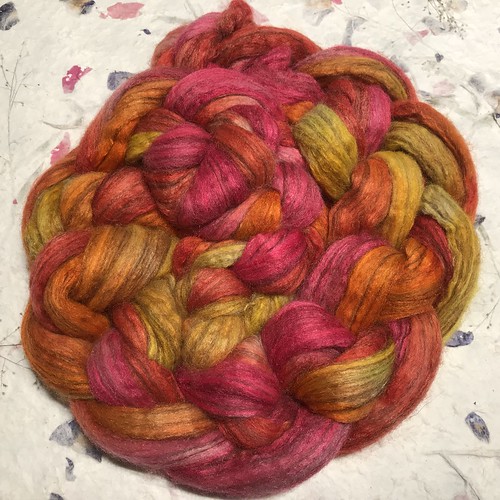 |

Tequila Sunset SOLD
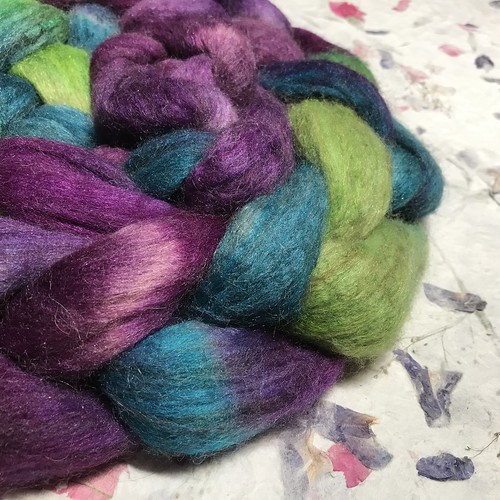
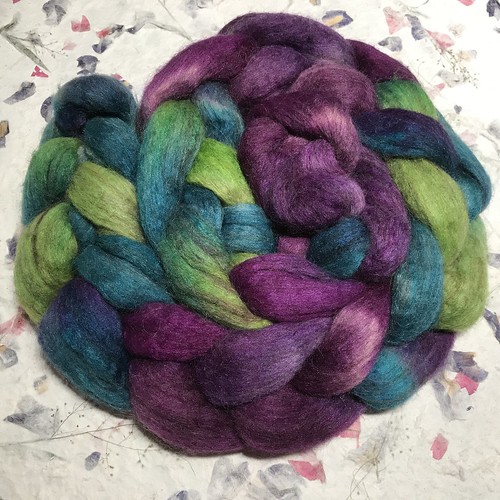 |

Peacock Party 1 LEFT
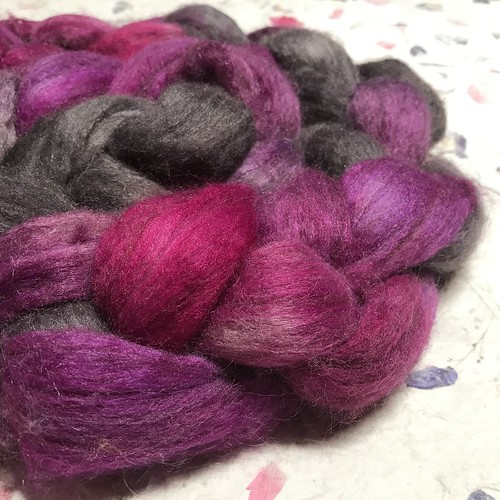
 |

When the Party is over 1 LEFT
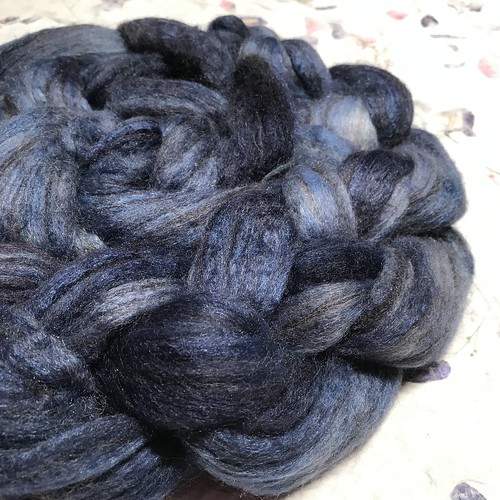
 |

Mood Indigo SOLD

 |

Cosmic SOLD

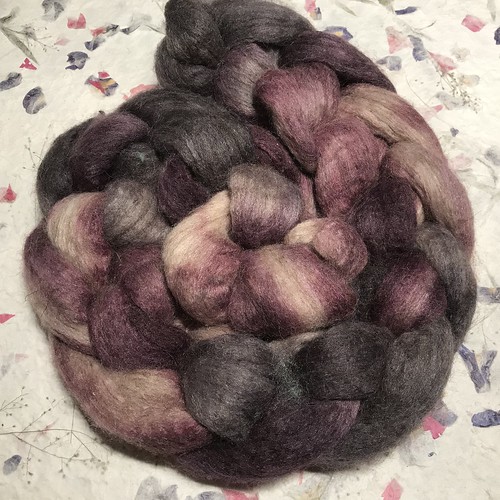 |

All Hallows SOLD

 |

The Big Freeze SOLD

 |

Wuthering Heights SOLD

 |

Scottish Heather 2 LEFT

 |

Peachy 1 LEFT


 Kata Tjuta
Kata Tjuta
(an intense pure red that goes well with the Kookaburra and the Wattle and the Amethyst colourway and soooooomany others)


 Kookaburra
Kookaburra
(a beautiful silver grey with ochre accents that complement the dingo colourway)

 Dingo
Dingo
( A beautiful warm honey ochre with pops of royal bluebell, kingfisher and kangaroo paw)

 Grevillea
Grevillea
(a gorgeous raspberry base with pops of royal bluebell, flowering gum, grey and daintree)


 Fern Forest
Fern Forest
( a deep forest green with accents of bright red, dusky purple and daintree) )

 Jacarandah
Jacarandah
( a fabulous deep purple with accents of royal bluebell, daintree, grevillea and kingfisher )

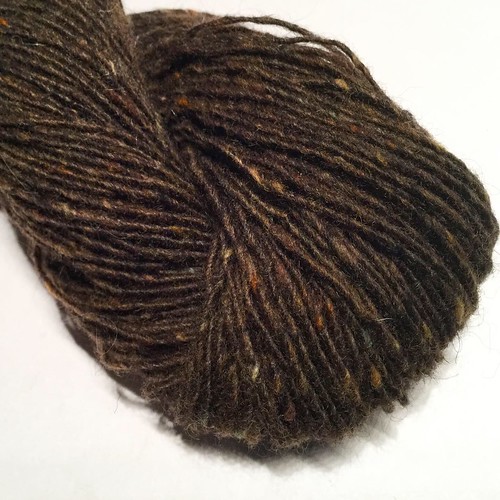 Wombat
Wombat
( a fabulous deep walnut brown with accents of dingo and kookaburra)

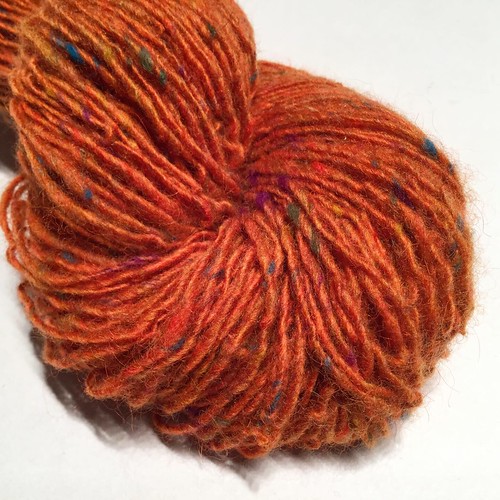 Kangaroo Paw
Kangaroo Paw
( a fabulous warm orange with accents of fern forest, royal bluebell and grevillea and dingo )


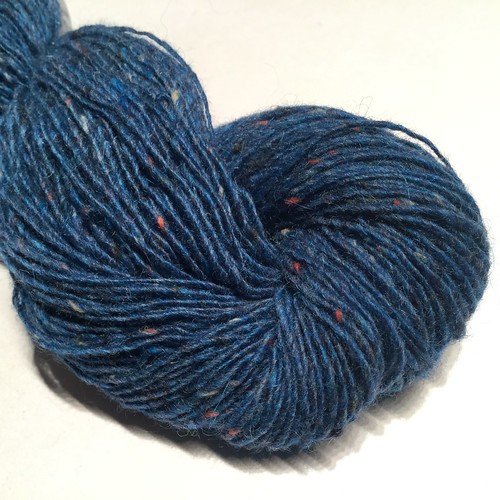 Royal Bluebell
Royal Bluebell
( a deep blue with accents of flowering gum, kookaburra and fern forest )

 Wallaby
Wallaby
( a warm light brown with accents of soft blue and kookaburra)

 Daintree ( a soft green with accents of fern forest and dingo)
Daintree ( a soft green with accents of fern forest and dingo)
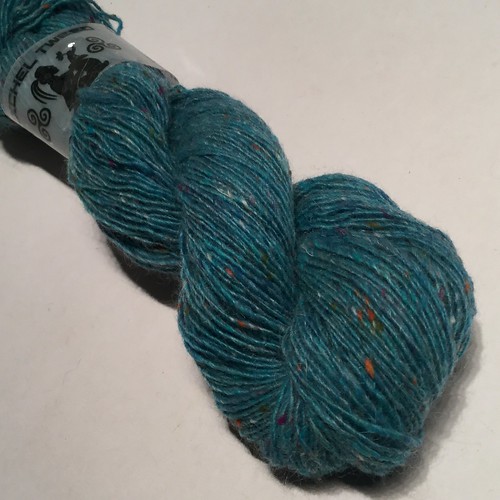
 Kingfisher
Kingfisher
( a fabulous Turquoise blue with accents of fern forest, kangaroo paw, Jacaranda and Grevillea)

IxCHeL Tweed fingering weight yarn
Super soft lambswool 70% and Kid Mohair 30%
Spun singles, fingering or sock weight yarn
+/- 200meters/218yards
50grams 1.76oz
AU$16
More colours will be available at the Pakenham show, including a Princess Bride colour range AND a naturally dyed and eco printed colour range ! Stay Tuned !

Wattle
(A beautiful sunshine yellow that goes so well with the kookaburra the silver grey)
(A beautiful sunshine yellow that goes so well with the kookaburra the silver grey)

 Kata Tjuta
Kata Tjuta (an intense pure red that goes well with the Kookaburra and the Wattle and the Amethyst colourway and soooooomany others)

Amethyst
(a bright purple colourway with bright red flecks)
(a bright purple colourway with bright red flecks)

 Kookaburra
Kookaburra(a beautiful silver grey with ochre accents that complement the dingo colourway)

 Dingo
Dingo( A beautiful warm honey ochre with pops of royal bluebell, kingfisher and kangaroo paw)

 Grevillea
Grevillea(a gorgeous raspberry base with pops of royal bluebell, flowering gum, grey and daintree)

Flowering Gum
( a gorgeous medieval warm red with bright red, kookaburra and fern forest accents)
( a gorgeous medieval warm red with bright red, kookaburra and fern forest accents)

 Fern Forest
Fern Forest ( a deep forest green with accents of bright red, dusky purple and daintree) )

 Jacarandah
Jacarandah ( a fabulous deep purple with accents of royal bluebell, daintree, grevillea and kingfisher )

 Wombat
Wombat( a fabulous deep walnut brown with accents of dingo and kookaburra)

 Kangaroo Paw
Kangaroo Paw ( a fabulous warm orange with accents of fern forest, royal bluebell and grevillea and dingo )

isn’t it gorgeous how the Kangaroo paw knits up?! )

 Royal Bluebell
Royal Bluebell ( a deep blue with accents of flowering gum, kookaburra and fern forest )

 Wallaby
Wallaby( a warm light brown with accents of soft blue and kookaburra)

 Daintree ( a soft green with accents of fern forest and dingo)
Daintree ( a soft green with accents of fern forest and dingo)
 Kingfisher
Kingfisher ( a fabulous Turquoise blue with accents of fern forest, kangaroo paw, Jacaranda and Grevillea)
Pm me if you would like to give some of these amazing new IxCHeL Tweed yarns or the Buddhas tears tea a good home or if you want to sign up for the IxCHeL Clubs ! Enjoy looking and have a fun weekend !
Please don't hesitate to contact me at any time if you have any questions okay? Always happy to enable. All my contact details are to be found at the end of this week’s blog entry.
IxCHeL Buddhas tears tea
carefully packed and presented in a special organza gift bag
50g/ AU$19
Two organically grown superior green tea leaves and a jasmine bud are plucked from the best quality tea bushes and mixed with delicately smelling jasmine blossoms, then sieved and hand rolled on bamboo trays, into small balls while the leaves are not quite dry.
The leaf captures the fine jasmine aroma and releases it during brewing, giving a champagne coloured cup.
Brewing: 1-3 minutes 75-80degC ,
4 pearls/cup,
you can reinfuse 3-4 times so those 4 pearls last a looong time

 Carefully handrolled tea
Carefully handrolled tea

Enjoy the tea over and over again, by adding hot water again and again
All my contact details are here:
Please don't hesitate to contact me at any time if you have any questions okay? Always happy to enable. All my contact details are to be found at the end of this week’s blog entry.
Have a fun weekend !!!
How To Order:
1. You can email me on ixchel at rabbit dot com dot au or ixchelbunny at yahoo dot com dot au
2. Message me on facebook or
3. Message me on www.ravelry.com where I am ixchelbunny.
4. message me on Instagram where I am @ixchelbunny
I will email you right back with all your order details and payment methods.
Any questions? Any custom orders for yarn or dyeing fibre? : Please don’t hesitate to ask! Always happy to enable.
Dates to put in your Calendar
 |

Carefully handrolled tea
 |
Enjoy the tea over and over again, by adding hot water again and again
All my contact details are here:
Have a fun weekend !!!
How To Order:
1. You can email me on ixchel at rabbit dot com dot au or ixchelbunny at yahoo dot com dot au
2. Message me on facebook or
3. Message me on www.ravelry.com where I am ixchelbunny.
4. message me on Instagram where I am @ixchelbunny
I will email you right back with all your order details and payment methods.
Any questions? Any custom orders for yarn or dyeing fibre? : Please don’t hesitate to ask! Always happy to enable.
2. Message me on facebook or
3. Message me on www.ravelry.com where I am ixchelbunny.
4. message me on Instagram where I am @ixchelbunny
I will email you right back with all your order details and payment methods.
Any questions? Any custom orders for yarn or dyeing fibre? : Please don’t hesitate to ask! Always happy to enable.
Dates to put in your Calendar
Grandvalley Spin In March 2020
More details to follow
RABBIT ON !
((hugs))
Charly





No comments:
Post a Comment